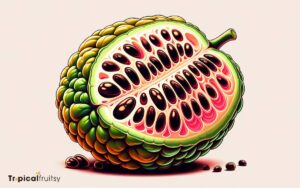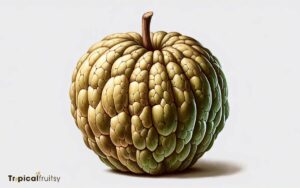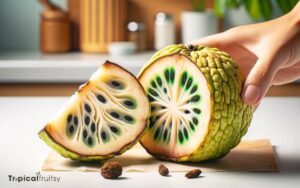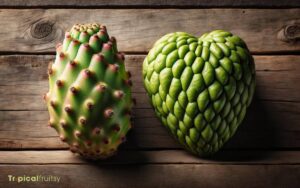Is Cherimoya the Same as Guanabana? Unveiling the Mystery!
Cherimoya and guanabana, also known as soursop, are not the same fruit. They are distinct tropical fruits with different flavors, textures, and nutritional values. Both belong to the Annonaceae family but differ in origin, appearance, and culinary uses.
Cherimoya (Annona cherimola) and guanabana (Annona muricata) belong to the same family but are different species.
To clarify:
While both fruits offer a delectable taste and health benefits, they are uniquely enjoyable in their own right.
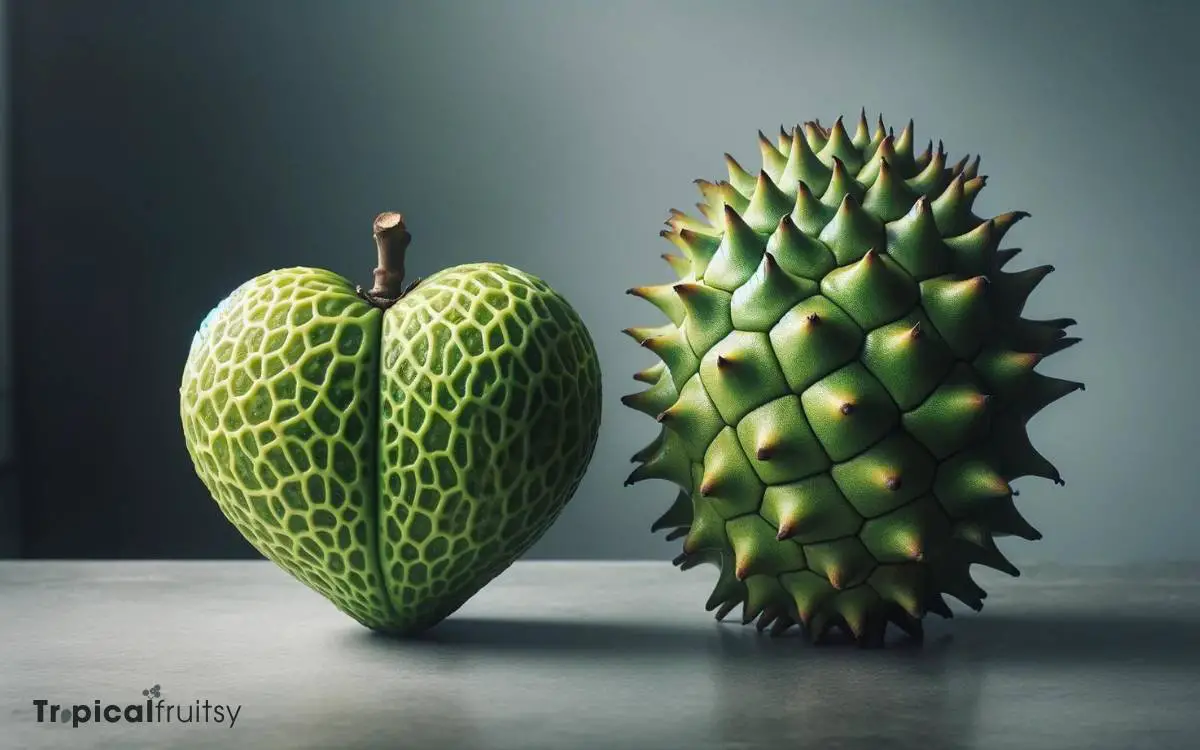
Key Takeaway
Cherimoya vs Guanabana: Understanding the Tropical Fruit Differences
| Feature | Cherimoya | Guanabana |
|---|---|---|
| Scientific Name | Annona cherimola | Annona muricata |
| Origin | Andes Mountains | Caribbean, Central and South America |
| Appearance | Green, heart-shaped, scaly skin | Green, spiky, oval shape |
| Size | Medium (about the size of a grapefruit) | Large (up to 15 inches long) |
| Taste | Sweet, resembling a blend of banana, pineapple, and strawberry | Sweet and sour, with a citrusy note |
| Culinary Uses | Eaten fresh, in desserts, and smoothies | Eaten fresh, in juices, ice creams, and sorbets |
| Nutritional Highlights | High in Vitamin C, B vitamins, fiber | High in Vitamin C, dietary fiber, and antioxidants |
Unveiling Cherimoya and Guanabana
Cherimoya and guanabana, often confused, are distinct tropical fruits that regularly grace exotic produce markets with their unique flavors and textures.
The cherimoya bears a green, heart-shaped exterior and has a creamy texture that’s reminiscent of a blend of banana, pineapple, and strawberry. It’s often enjoyed raw and is prized for its custard-like flesh.
Conversely, guanabana, also known as soursop, has a spiky green skin and is larger than the cherimoya.
Its flavor is a complex mix of sweet and tart, described as a combination of strawberry and apple with citrusy notes. This fruit isn’t only consumed fresh but also popular in juices, ice creams, and other desserts.
Understanding their distinctive characteristics paves the way for exploring their origins and botanical background.
Origins and Botanical Background
Where do cherimoya and guanabana originate, and what sets them apart in the botanical world?
Cherimoya, known scientifically as Annona cherimola, traces its roots to the Andes mountains in South America.
Guanabana, or graviola, bears the scientific name Annona muricata and is native to the tropical regions of the Americas, particularly the Caribbean.
Both fruits belong to the Annonaceae family, which distinguishes them as relatives in the plant kingdom. Despite their familial connection, they differ significantly in appearance and growth conditions.
Cherimoya thrives in high-altitude, subtropical environments, whereas guanabana prefers lowland tropics with higher humidity.
These origins influence their botanical characteristics, such as leaf structure, fruit texture, and flavor profile, underpinning their unique identities within the diverse Annonaceae family.
Comparing Physical Characteristics
Cherimoya and guanabana are often mistaken for one another, yet they exhibit distinct physical characteristics.
While cherimoya typically presents a heart-shaped profile, guanabana bears a more elongated, spiky form.
The skin texture of cherimoya is smoother with slight depressions, contrasting sharply with the tough, prickly exterior of guanabana.
Fruit Shape Differences
Commonly, the cherimoya exhibits a heart-shaped form, while guanabana’s shape is more elongated and irregular. These distinctive physical characteristics are key identifiers.
The cherimoya, with its rounded contours, typically matures to about 10 to 20 centimeters in length. Its surface appears segmented into scales or platelets, which can range from smooth to slightly textured.
In contrast, the guanabana, also known as soursop, can grow considerably larger, often reaching up to 30 centimeters.
It boasts a spiky, tough exterior with a pronounced, almost reptilian pattern. This fruit’s size and protuberances contribute to its less uniform appearance.
The contrast in form between cherimoya and guanabana is unmistakable, providing a clear visual cue to differentiate the two fruits.
Skin Texture Contrast
Delving further into their physical distinctions, cherimoya’s skin is marked by a finer, more delicate texture in contrast to guanabana’s coarse, spiky surface.
The cherimoya’s skin boasts a series of shallow indentations that impart a unique pattern, somewhat akin to overlapping scales or fingerprints.
This intricate detailing allows for easier handling, as its surface lacks the pronounced protuberances found on guanabana.
Conversely, guanabana, also known as soursop, is readily identifiable by its thick, armored exterior. The green skin is covered in fleshy spines, which, while not sharp, provide a formidable, distinctive appearance.
These textural traits not only differentiate the two fruits visually but also influence the way they’re prepared and consumed.
With the physical characteristics compared, let’s delve into the taste test: flavor profiles explored.
Taste Test: Flavor Profiles Explored
A taste test reveals that, while both fruits boast a creamy texture, cherimoya’s flavor is subtly sweet with notes of banana, pineapple, and papaya, whereas guanabana, also known as soursop, offers a sharper, more citrusy profile.
Connoisseurs might note the following distinctions:
- Cherimoya’s sweetness is often likened to a blend of tropical fruits.
- Its texture is custard-like, perfect for spoon-eating.
- Guanabana’s tangy edge hints at strawberry and apple, with a touch of sour citrus.
- The fruit’s fibrous flesh requires more effort to consume than cherimoya’s creaminess.
These nuances in taste and texture contribute to each fruit’s unique appeal. Understanding their flavor profiles leads naturally to an exploration of their nutritional values and health benefits.
Nutritional Values and Health Benefits
While both cherimoya and guanabana are rich in vitamins and minerals, they offer distinct health benefits that cater to diverse dietary needs.
Cherimoya is particularly high in vitamin C, fiber, and contains essential antioxidants that support immune function and promote heart health. It’s also a good source of potassium, which is vital for maintaining proper blood pressure levels.
Guanabana, on the other hand, is celebrated for its anti-inflammatory properties and is often researched for potential anti-cancer effects due to its acetogenins content.
It’s also a potent source of vitamin B, which aids in metabolic processes, and provides a substantial amount of fiber for digestive health.
Both fruits contribute to a balanced diet, but they excel in different aspects of nutrition and wellness.
Culinary Uses and Recipe Ideas
Although cherimoya and guanabana differ in their nutritional profiles, they’re both versatile ingredients in the kitchen, lending their unique flavors to a variety of recipes.
Food enthusiasts utilize these tropical fruits to create delectable dishes that range from simple to complex.
Here are several ways to incorporate them into your culinary repertoire:
- Smoothies and Shakes: Blend the creamy flesh with other fruits or milk for a refreshing beverage.
- Desserts: Incorporate into ice creams, sorbets, or custards for a tropical twist.
- Salads: Mix with greens and other fruits for a sweet and savory combination.
- Sauces and Marinades: Puree and use as a base for a tangy sauce or marinade for meats and seafood.
Experimenting with cherimoya and guanabana can add an exotic touch to everyday meals.
Growing Regions and Availability
Cherimoya and guanabana thrive in distinct climate zones. Cherimoya favors mild, high-altitude conditions, while guanabana requires tropical, humid environments.
They both have specific seasonal harvest times, which affects their availability in global markets.
Consumers will find cherimoya’s peak season in the late winter and spring, while guanabana is typically harvested from summer to fall.
Optimal Climate Zones
Despite their similarities, cherimoya and guanabana thrive in distinct climate zones. Cherimoya prefers milder subtropical regions, while guanabana flourishes in more tropical environments.
Their cultivation and availability are influenced by these climate preferences, which dictate where they can be grown successfully.
Optimal conditions for each fruit include:
- Cherimoya: Elevations of 700 to 2400 meters, with temperatures between 15°C and 25°C.
- Guanabana: Lower elevations, thriving in warm, humid conditions with temperatures typically above 25°C.
- Cherimoya: Requires well-drained soil and is sensitive to excessive heat and cold.
- Guanabana: Prefers deep, rich soils and can tolerate brief cold spells better than cherimoya.
These climate requirements mean cherimoya is commonly found in countries like Spain and the United States (California), while guanabana is widespread in the Caribbean, Central and South America.
Seasonal Harvest Times
Understanding the seasonal harvest times of cherimoya and guanabana is essential for consumers seeking their fresh, exotic flavors.
Cherimoya typically flourishes in the cooler months, with peak seasons in various growing regions, like California and South America, falling between fall and spring. The subtropical climate of these areas provides the ideal conditions for cherimoya to thrive.
Guanabana, on the other hand, favors the tropical environments found in the Caribbean, Central and South America, and Southeast Asia.
Its harvest time often spans from late winter to summer, with some variation depending on the specific location’s climate and weather patterns.
Availability may fluctuate, but these fruits generally reach markets shortly after harvest, allowing consumers to enjoy their unique tastes when in season.
Conclusion
In a twist of nature’s irony, cherimoya and guanabana, while often mixed up, stand poles apart in their own right.
Each boasts a unique profile, from distinctive flavors to diverse health benefits, yet they share a common misidentity.
Whether it’s in a smoothie or a tropical dish, their exclusive qualities shine through. As exotic fruits, they’re not just a treat for the palate but a testament to the biodiversity that keeps food enthusiasts guessing and gardens ever so interesting.

